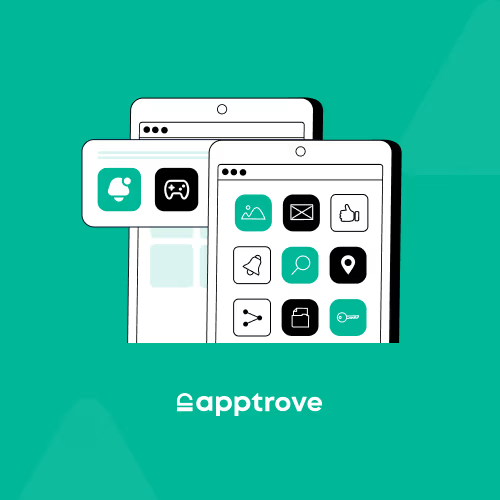Get Your App in Front of Users Before They Even Open the App Store
You’re probably spending your budget on ads in the app store, influencer promotions, or bidding on social media platforms. Even so, there’s a leading way to get millions of people ready to install your apps through OEM advertising. Have you been surprised that some apps are there on your fresh device, before you ever check the Play Store? This is made possible because of the magic of preload.
OEM advertising allows you to market your app to your phone’s and network’s users. Just imagine getting top-quality land right on the body and not only the display of your phone. After users turn on their new devices, they will see your app preloaded or shown in a special section. If you’re curious about how this works, take a look at our OEM marketing blog to explore how brands are using it to get ahead.
Why should you put preroll campaigns at the core of how you expand your business? It’s ideal to advertise at this moment as they are installing apps when they get their phones. No ads or apps to stop you, only you exploring the screen on a device with no apps installed.
The highlight of all this is that the program is secure with your data, inexpensive, and you can track its results accurately once set up well.
Why Is It More Important Now Than Ever
Has it been some time since you set up a new phone? You looked at the apps that came with your tablet, right? The time when you should capture your pre-roll campaigns is now. You won’t bother people with your messages and you won’t be fighting against multiple social ads. Usually, you’re interacting with users because they really want to try out their device’s features.
This channel has become smarter without losing its accessibility. Now, phone companies pick their preinstalled apps more wisely, so your app doesn’t have to deal with much competition. At the same time, new measurement tools have helped you get the information you need for successful scaling.
Your competitors? The majority of people still miss the importance of this channel. Since they’re in competition, you can pay a little to reach and appeal to important users.
Here, you’ll find out all about OEM campaigns, why they are some of the sharpest methods to acquire users, and what it takes to make a preload strategy that works. Are you keen to access the next level of mobile growth?
What is OEM Advertising, and Why It’s a Big Deal in 2025
Picture your typical marketing day: You’re juggling social media budgets, tweaking app store listings, and watching your cost-per-install creep higher on ad networks. Sound familiar? Now imagine if you could skip all that chaos and meet your users at the one moment when they’re genuinely excited to discover new apps, right when they’re unboxing their shiny new phone.
That’s exactly what OEM advertising makes possible.
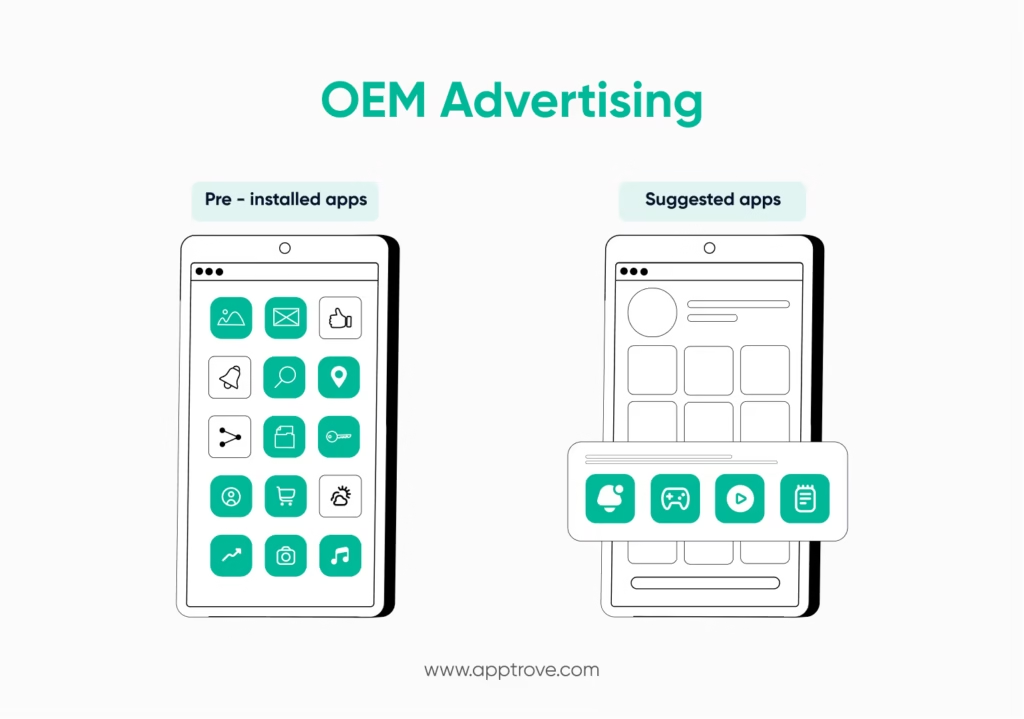
OEM stands for Original Equipment Manufacturer, think Samsung, Xiaomi, Oppo, and the other companies actually building the smartphones in your pocket. When you partner with these manufacturers through OEM advertising, your app can show up pre-installed on devices or get featured during the initial setup process. It’s what we call a preload campaign, and honestly? It’s like having backstage passes to your user’s attention.
Here’s what makes this completely different from your usual user acquisition hustle: Most marketing tactics are trying to interrupt users who’ve already settled into their app routines and downloaded their favorites. You’re competing for scraps of attention in crowded feeds and auction-based ad platforms. In fact, OEM-installed apps have an 80% higher installation rate compared to apps downloaded through traditional channels, making this strategy not only timely but also highly effective.
But OEM advertising? You’re there at the beginning of their journey, when they’re still in discovery mode and genuinely curious about what their new device can do.
Why This Approach is Changing Everything
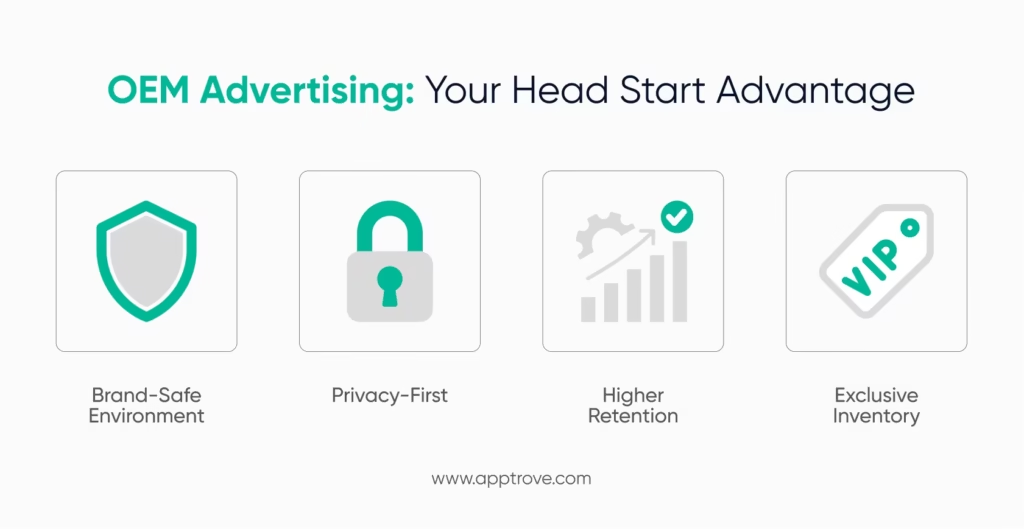
Think about it this way:
Brand-safe placements— You’re not rolling the dice with random ad networks or hoping your ad doesn’t appear next to questionable content. You’re working directly with reputable manufacturers.
Privacy-friendly by default— No complex tracking setups, no worrying about iOS updates breaking your attribution, and no users opting out of data collection. It just works.
Better retention— Users who discover your app during device setup tend to stick around longer. They’re not impulse-downloading; they’re thoughtfully choosing what belongs on their home screen.
Exclusive access— Your competitors can’t just outbid you here. These placements aren’t available through your typical user acquisition channels.
In a world where grabbing attention gets more expensive every quarter and privacy regulations keep tightening, OEM advertising gives you something invaluable: a genuine head start with users who are actually ready to engage.
And that head start? It’s often the difference between sustainable growth and constantly fighting uphill battles in saturated markets.
Preload Campaigns Unlocked: How OEMs Help You Gain New Users
Probably, all you think about when you hear “preloaded” is those unnecessary apps you lose on your new phone in a matter of minutes. Don’t worry; this happens to all of us as we hastily remove the preinstalled apps to start using our phones. Even so, today’s preload events are completely different from that unhappy situation.
A preload campaign means your application is shown on a new device right before the user turns it on. Commonly, the app is found on the home screen, can be saved to a folder that fits its style, or is shown in setup as a suggested item. “Since you’re in this part of the world, and you like this kind of music, I think you may enjoy using this app.”
Imagine each one of these scenarios:
You can start your New Year’s fitness goals right away since it’ll be on your new phone by the time January comes.
When people in emerging countries set up their devices for the first time, they are greeted by the fintech app.
An app that provides a new surprise on your phone you bought when you arrive at the airport before your trip
When the information is planned, punctual, and meets what you really require, you can relate to it.
When Preload Campaigns Make Perfect Sense
New product releases- Operating in the same way, you can introduce your iPad app to users without their recognition of a need. You won’t have to compete or work your way through the applications available in the stores.
Expansion- Are you planning to do business in another nation? Trust from well-known manufacturers is immediately given to any business using preload campaigns.
Retargeting- Make sure to contact earlier enthusiastic users who haven’t used your app for several months. Whenever they buy a new phone, you can help right away.
Let’s Get Rid of the Myths That Prevent You from Progressing
People usually do not trust preloaded apps, but when your app is useful and appears at the proper moment, they will like it. User engagement and retention usually turn out to be better than regular acquisition statistics.
Right after starting the phone, people delete those preinstalled apps without a second thought. When something happens can make a big difference.
OEM campaigns don’t fit the budget and aren’t flexible. In fact, OEM campaigns allow for changes depending on region, device, and price. Also, you usually get the best bang for your buck compared to social or programmatic advertising.
The Real Talk: What You’re Getting Into
The amazing parts:
- You’re capturing attention at the exact moment users are making app decisions
- Lower churn rates because these users genuinely chose to keep your app
- Brand-safe placements with built-in privacy protection
- Precise targeting by device type, price point, and geography
The challenges you should know about:
- You’ll need to plan ahead and build relationships with OEM partners
- Creative formats might be more limited than your usual ad campaigns
- Attribution can get tricky without the right measurement setup
Bottom line: Preload campaigns put you front and center when users are most open to discovering new apps. The secret sauce? Making your app feel like exactly what they needed, right when they needed it, not just another icon taking up space.
Building the Perfect OEM Campaign: Strategy, Targeting, and Formats
You’re convinced that OEM advertising could transform your user acquisition strategy. Now comes the critical part- actually building a campaign that delivers measurable results, not just impression placement metrics.
Here’s what makes OEM campaigns different: unlike traditional UA channels, where you set a budget, upload creative and launch, OEM campaigns require strategic thinking. This isn’t a limitation — it’s your competitive advantage. You get precise control, sophisticated targeting options, and placements that integrate seamlessly into the user experience.
Your Strategic Framework for OEM Campaign Success
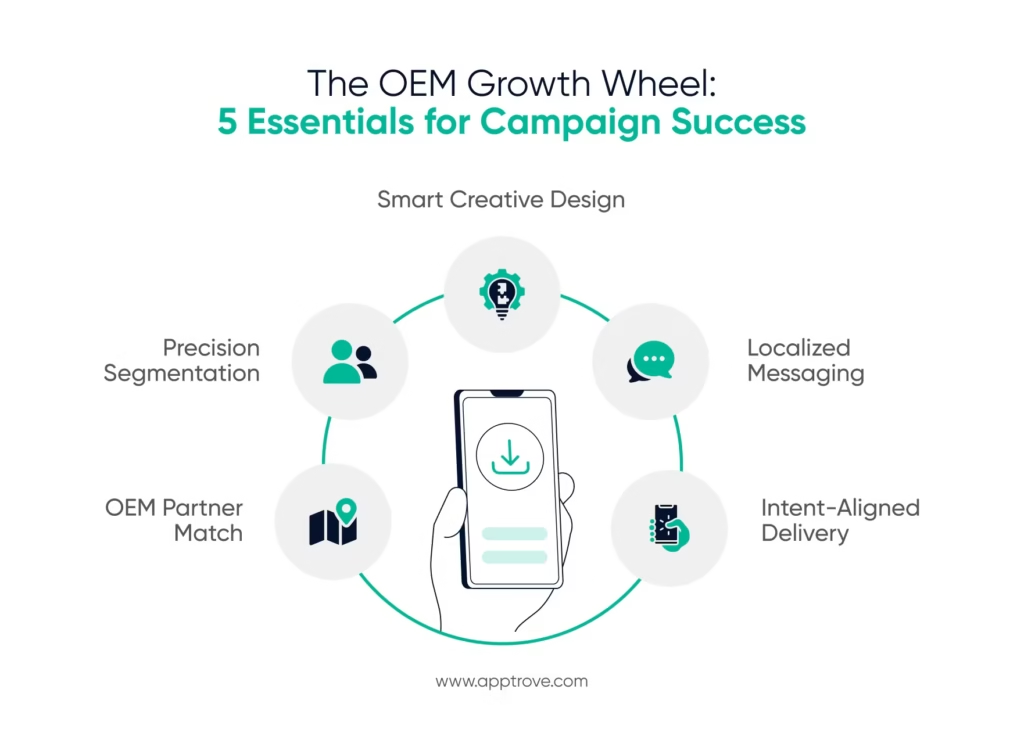
Choose Your OEM Partners Strategically
- You need to align your audience with the right manufacturers. Are you targeting premium users who invest in flagship devices? Cost-conscious markets where value drives decisions? Specific niches that favor particular brands? Different OEMs dominate different geographical regions and user segments — your success depends on matching your target audience to the optimal manufacturer partnerships.
Develop Precision User Segmentation
- Your fitness app targeting Gen Z users in North America should have a completely different positioning than a fintech app reaching working professionals in Southeast Asia. OEM campaigns give you the flexibility to customize messaging, visual elements, and even feature sets based on exactly who will encounter your app and their local context.
Design Format-Appropriate Creative Assets
You’re working with entirely different creative opportunities than standard display advertising:
- Strategic icon placement on home screens
- Engaging splash screens during device setup
- Curated recommendations within app discovery interfaces
- Contextual notifications or branded widgets post-setup
Each format serves users in distinct moments with different attention levels. Your productivity app icon should communicate essential utility, while your entertainment app splash screen can leverage compelling visuals and urgency-driven messaging.
Implement Localized Customization
Generic approaches fail in OEM campaigns. Users in different regions respond to varying design preferences, feature priorities, and app categories. You should develop localized messaging strategies, region-specific promotional offers, and potentially different app versions (such as lite variants for bandwidth-conscious markets).
Align Your Messaging With User Intent
This represents a fundamental shift in approach. You’re not interrupting users during their daily routines — you’re engaging them during device setup when they’re actively curating their app ecosystem. Your messaging should feel consultative and helpful rather than promotional. Focus on demonstrating clear value, building trust, and solving genuine user problems.
When you execute OEM campaigns effectively, they don’t register as advertising. Instead, they feel like intelligent recommendations that enhance the user’s device experience — and that’s precisely how you generate installs that convert into engaged, long-term users.
Measuring Success: Preload Attribution, Metrics & Pitfalls to Avoid
You’ve put in the work, built the partnerships, and your app is now greeting users on their brand-new devices. But here’s where things get interesting — figuring out whether those strategic placements are actually driving the results you need.
Preload campaigns throw the traditional attribution playbook out the window. There’s no ad click to track, no moment when someone taps “Install” in the app store. Your app was simply there, waiting patiently on their home screen from day one. This fundamental difference is exactly why preload attribution requires a completely fresh approach to measurement.
Why Your Usual Attribution Methods Won’t Work Here
Think about your typical user acquisition campaign. You track clicks, rely on SKAN postbacks, or use tracking links to connect the dots between seeing your ad and installing your app. With OEM advertising, that entire chain doesn’t exist — the install happened silently before the user even powered on their device.
The question shifts from “Did my ad drive an install?” to something much more valuable: “Did the user actually engage with my app, and what did they do once they discovered it?”
The Metrics That Actually Matter For Your Success
Instead of chasing vanity metrics, focus on these indicators that reveal genuine user value:
Open rate — What percentage of users who received your preloaded app actually opened it? This tells you if your placement and positioning resonated.
Timing patterns — Are users opening your app during initial setup when they’re exploring everything? Or weeks later, when they have a specific need? Understanding this timing helps you optimize future campaigns.
Retention depth — The real test isn’t just whether they opened your app once, but whether they return after a week, then a month. Preloaded users often show different retention patterns than acquired users.
Meaningful engagement — Are users just opening and closing your app, or are they signing up, completing key actions, and reaching those “aha” moments that indicate real value?
These signals paint a complete picture of whether your app didn’t just get installed, but actually became useful in someone’s life.
Common Pitfalls That Could Derail Your Campaigns
Even experienced marketers stumble with preload attribution. Here’s what to watch out for:
Campaign tagging oversights — Without proper source labeling, you’ll lose track of which OEM partnerships and device types are driving your best users. Always implement clear tracking from the start.
Impatient measurement windows — Some users dive into preloaded apps immediately, while others take weeks to explore. If you’re only measuring Day 1 or Day 3 engagement, you’re missing a significant portion of your user base.
Surface-level success metrics — A single app open doesn’t indicate success. You need to understand what users accomplish inside your app and whether they find enough value to return.
Outdated tracking approaches — Privacy-invasive methods like device fingerprinting aren’t just risky — they’re often ineffective for preload campaigns anyway.
The Privacy Advantage That Actually Works in Your Favor
Here’s something refreshing: Preload campaigns are naturally more privacy-friendly than most acquisition channels. You don’t need aggressive retargeting or extensive personal data collection to make them work effectively.
Your measurement strategy should focus on:
Transparent on-device identifiers that users understand and consent to.
Campaign-level analysis that reveals patterns without invasive individual tracking. Server-side integration of data from your trusted OEM partnerships.
Ultimately, success in preload campaigns isn’t about impressive open rates or flashy download numbers. It’s about creating experiences so relevant and helpful that users choose to keep your app in their daily routines — and that’s a much more valuable metric than any click-through rate.
The OEM Inventory Advantage: Why Android is a Goldmine for Smart Marketers
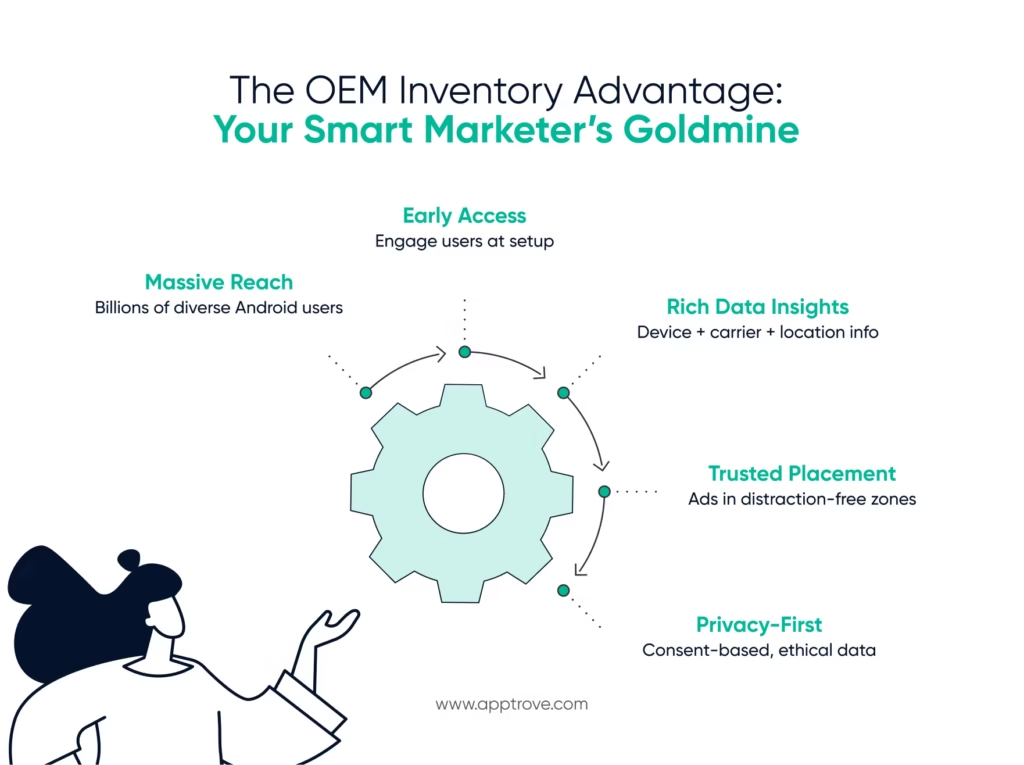
You already know the Android ecosystem is enormous, with billions of users across dozens of manufacturers, countless device types, and every price point imaginable. But here’s what most marketers are missing: Android OEM inventory isn’t just massive. It’s remarkably sophisticated.
When you secure the right partnerships, you’re not simply purchasing ad placements, you’re gaining direct access to users during their most receptive moments, before they’ve been overwhelmed by app store choices or developed their preferences. That early access isn’t just valuable — it’s transformative for your acquisition strategy.
Why OEM Channels Give You Data That Actually Matters
Running campaigns through OEM channels gives you insights that typical programmatic inventory simply can’t provide. You get granular, device-level intelligence including:
- The specific model your user owns (and what that reveals about their preferences)
- Which carrier they chose (indicating regional and spending patterns)
- Their precise location, down to language and cultural preferences
- Whether their device is brand new, refurbished, or an upgrade (showing their relationship with technology)
This contextual richness lets you craft messaging that feels personally relevant, whether you’re engaging power users who invest in flagship devices or reaching value-conscious users in emerging markets who prioritize functionality over features.
Why OEM Placements Outperform Traditional Inventory Every Time
Unlike standard ad networks where you’re competing for attention in crowded feeds, OEM placements exist in trusted, distraction-free environments. Your app appears during device setup or on clean home screens, precisely when users are actively exploring and in genuine discovery mode.
The credibility factor is massive. When your app comes recommended through the device itself, users perceive it as vetted and trustworthy rather than interruptive advertising. This leads to authentic-feeling installs from users who are genuinely interested in what you’re offering, not just accidentally clicking through. In fact, pre-installed apps have a 38% higher install rate than those not pre-installed.
Privacy Protection That Actually Strengthens Your Strategy
Privacy concerns aren’t going away — if anything, they’re intensifying in 2025. You’re already dealing with stricter regulations, limited tracking capabilities, and increasingly privacy-conscious users. OEM campaigns offer a refreshing solution to these challenges.
The approach is fundamentally different. There’s no reliance on questionable tracking methods, no third-party cookies, and no personal data being exchanged without transparency. Instead, you get clean, consent-based data through direct manufacturer integrations that respect user privacy while delivering the insights you need.
If you’re serious about scaling sustainably, targeting with precision, and moving beyond wasteful broad-reach campaigns, OEM inventory provides a genuine competitive advantage. This isn’t about finding clever workarounds — it’s about building a more ethical and effective approach to mobile marketing that will serve you well as the industry continues evolving.
From Campaign Launch to Optimization: How to Keep Performance on Point
You’ve launched your OEM campaign and your app is now living on brand-new devices. Congratulations — but here’s where the real challenge begins. Keeping performance strong, ensuring installs translate to value, and maintaining user engagement over time.
The advantage of OEM campaigns? They give you the control and flexibility to optimize intelligently — but only if you approach testing and refinement with clear intention and systematic thinking.
Start With Strategic Creative and Placement Testing
Every placement tells a different story, and every creative message resonates differently with your audience. One user might immediately connect with a simple “Get Started” icon on their home screen. Another needs a compelling splash screen visual to spark enough curiosity to explore further.
Your testing approach should be methodical:
Visual rotation across different contexts- What works in North America might fall flat in Southeast Asia.
Placement comparison studies- Compare home screen icon performance against setup flow recommendations.
Message angle experiments- Test utility-focused messaging against emotional appeals, or promotional offers against pure value propositions
This isn’t about throwing creatives at the wall to see what sticks. You’re building a systematic feedback loop that connects creative choices to user behavior patterns.
Unlock Insights Through Cohort-Based Analysis
Instead of analyzing all your installs as one homogeneous group, segment by meaningful cohorts — group users by device type, geographical region, or activation timing. This approach reveals critical insights:
- Which device categories consistently deliver users with superior retention rates
- How messaging effectiveness varies across different markets and cultures
- Whether user engagement strengthens over time or deteriorates after the initial install experience
When you analyze behavior through cohort lenses, you shift from asking “What’s our overall retention rate?” to asking “Where are our highest-value users originating, and what specific factors drive their engagement?”
Design for the Complete User Lifecycle
OEM campaigns extend far beyond getting your app onto devices. You need to maintain relevance and value throughout the entire user journey.
Map your user lifecycle strategically and align every touchpoint:
Install phase — Create onboarding experiences that acknowledge how users discovered your app and match their initial context.
Engagement phase — Deploy in-app guidance, strategic notifications, and meaningful rewards that encourage first meaningful actions.
Re-engagement phase — When users haven’t returned within a week, send value-focused communications or introduce compelling new features
Every interaction should feel appropriately timed, genuinely useful, and connected to the authentic role your app serves in their daily routine.
Balance Automation With Strategic Manual Oversight
You don’t need to micromanage every campaign element, but you do need to be strategic about what you automate versus what requires your direct attention.
Automate these elements:
- Creative rotation based on regional preferences and device specifications
- Behavioral notification triggers that respond to in-app user actions
- Attribution tracking setup and install the cohort organization
Monitor manually (especially initially):
- Post-install conversion funnel performance, identifying exactly where users engage and where they disconnect
- Retention pattern analysis by OEM partnership and specific campaign elements
- Creative asset performance across different formats and placement types
OEM campaigns offer you significantly more control than traditional acquisition channels. With the right optimization systems in place, you can evolve from a “launch and hope” approach to launch, test systematically, and scale intelligently.
Pro Tips: Scaling OEM Advertising Without Burning Budget
Your initial OEM campaigns are delivering solid results, and now you’re ready to ask the big question: How do we take this success and multiply it? But here’s the thing about scaling — it’s not just about increasing your spend. True scaling means expanding strategically, ensuring every new placement, market, and device partnership delivers the performance you need to justify the investment.
You can grow your OEM presence while keeping campaigns efficient, targeted, and budget-conscious. Here’s how to do it right.
Take a Staged Approach to Expansion
The fastest way to waste your scaling budget? Trying to go everywhere at once.
Instead, build your expansion methodically through a tiered rollout strategy:
Phase 1: Pilot testing- Partner with one OEM, focus on one region, test one core message. Phase 2: Market validation- Expand to a few different geographical areas, experiment with local languages, or test various device price tiers.
Phase 3: Confident scaling- Once you have solid engagement and retention data proving what works, invest more aggressively in your winning combinations.
This approach lets you learn quickly, adjust your strategy early, and avoid throwing budget at unvalidated concepts that might not perform in different contexts.
Combine Preload Placement With Strategic Remarketing
Getting your app preloaded is incredibly powerful, but not every user opens it immediately. Some need time to settle into their new device, others need the right moment or trigger. That’s where strategic remarketing becomes your competitive advantage.
Think of this as a coordinated approach:
OEM placement gets your app onto their device with perfect timing. Remarketing efforts provide thoughtful nudges when your app becomes most relevant to their needs
You can execute this through personalized push notifications, contextual in-app messages, or even owned communication channels like email. The key is being helpful rather than pushy, showing up when your app genuinely adds value to their experience.
Allocate Budget Based on Performance Intelligence
OEM inventory spans an enormous range, but not every placement opportunity deserves the same investment. Some device categories consistently drive high-value conversions, while others work better for awareness and reach. Your success depends on understanding these distinctions clearly.
Develop a more strategic budget allocation framework:
Premium flagship devices- Ideal for targeting users with higher lifetime value potential. Entry-level smartphones- Perfect for utility apps, freemium models, or value-focused offerings.
Specific regional or carrier partnerships- Often deliver superior retention rates, depending on your app category.
Let your actual performance data guide your spending decisions — investing more heavily where results justify it and being more conservative where the returns don’t support aggressive scaling.
Protect Your Investment With Thorough Quality Assurance
When you’re scaling quickly, it’s easy to overlook small details that can significantly impact your results.
Before launching into new markets or OEM partnerships, implement a systematic QA process:
Technical verification- Confirm your campaign tracking and attribution systems are functioning correctly
Creative optimization- Ensure your visual assets display properly across different screen sizes and operating system versions
Measurement accuracy- Verify you’re tracking meaningful engagement metrics, not just surface-level install numbers
Event validation- Double-check that your post-install tracking accurately reflects genuine user actions
This quality assurance step protects your scaling budget, prevents misleading performance data, and ensures you’re extracting valuable insights from every campaign investment.
What’s Coming Next in OEM Advertising? The Trends You Need to Watch
So here we are at the end of this guide, but honestly? This is just the start of what you could achieve.
You’ve dug into how OEM advertising actually works, figured out the mechanics of preload campaigns, and learned how to scale smartly. But here’s what I want you to remember: OEM is still changing fast. The marketers who’ll win next year won’t be the ones copying what worked yesterday—they’ll be the ones figuring out what works tomorrow.
Let us show you where the real opportunities are hiding.
New Marketers are Exploding (And You Should Pay Attention)
Emerging regions aren’t just growing—they’re becoming the heart of mobile-first behavior. Think about it: for someone in Southeast Asia, Africa, or Latin America, that preloaded app on their phone isn’t just handy. It’s literally their first brand experience ever.
That changes everything. Your preload campaigns in these regions aren’t nice-to-haves anymore. They’re strategic necessities.
You’ll want to focus on local OEM partnerships, messaging that actually resonates with each region, and lighter app versions that work on budget devices. Do this right, and you’re not just getting installs—you’re building genuine user relationships from day one.
You Can Target Smarter Without Being Creepy
AI is reshaping everything, and in OEM advertising, it’s letting you target with context instead of personal data. Pretty powerful stuff.
You can use device signals—phone model, location, carrier—to serve exactly the right message at exactly the right moment. No need to dive into those privacy gray areas that make everyone uncomfortable. And with privacy laws getting stricter everywhere, this isn’t just smart marketing. It’s essential.
Your Analytics Can Finally Make Sense
While everyone else is struggling with iOS 14.5 and privacy-first measurement headaches, OEM campaigns give you something precious: clean, straightforward attribution. No messy SKAN workarounds. No educated guessing.
You get deterministic data and clear user journeys. You can actually measure real impact while staying completely compliant and respectful of your users. It’s refreshing, honestly.
Stop Counting Installs, Start Predicting Behavior
The future isn’t about how many downloads you got. It’s about understanding what those users will actually do next.
When you layer predictive modeling over your OEM insights, you shift from reacting to what happened to anticipating what will happen:
Which users will stick around past week one? Which phone models correlate with your highest-value customers? How can you adjust your creative or timing to improve retention rates?
This is where OEM stops being just another ad channel and becomes your competitive edge.
Here’s The Reality
OEM advertising isn’t just having a moment—it’s becoming essential for marketers who think beyond next quarter, respect user privacy, and want performance that actually matters.
You don’t need to revolutionize everything overnight. But you do need to start being intentional about this.
Test things out. Learn what works for your specific audience. Keep refining your approach. And always, always keep your users at the center of every decision you make.
Your next growth breakthrough might already be sitting there, preloaded and waiting. Curious to see how this could work for you? Book a quick demo or start exploring with a free trial — no pressure, just a chance to see what’s possible.
